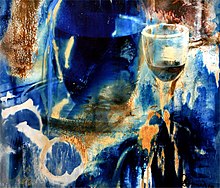Chemogram

A chemogram (from “chemistry”, “optics” and grámma “letter”, “writing”) is an experimental work of art in which a photographic image is partially or fully enlarged on photo paper in the darkroom and then selectively in daylight with chemicals from the Photo development is painted on the photo paper. Because of the manufacturing technique , chemograms can be assigned to abstract photography .
Chemograms were invented in 1974 by the photo artist Josef H. Neumann .
history

Chemograms are a further development of chimigrams , which were originally invented in 1956 by the Belgian artist Pierre Cordier . Although Johann Schulze, Hippolyte Bayard , Maurice Tabard and Edmund Kesting had previously carried out experiments to produce chemigram-like images, Pierre Cordier is considered to be the pioneer of the chimigram in terms of the development of the chimigram as a means of artistic expression.
The term “chemogram” was coined in 1976 by the photo designer Josef H. Neumann from Dortmund, which differs from the expression “Chimigramm” by the Belgian artist Pierre Cordier . He had learned the technique of producing chimigrams from his professor Pan Walther , who in turn had taken them over from the artist Edmund Kesting , who also came from Dresden .
Neumann not only worked with a brush or cotton ball on black and white photo paper, but also exposed photos during the process. This is how Neumann's chemogram at the beginning of the 1970s differs from the previously cameraless photogram created over decades . These works of art were made by various important artists almost at the same time as the invention of photography in the 19th century, such as Hippolyte Bayard , who were outstanding in the early stages , Thomas Wedgwood , William Henry Fox Talbot and later in the twenties Man Ray and László Moholy-Nagy as well as in the thirties by the painters Edmund Kesting and Christian Schad by draping objects directly on appropriately sensitized photo paper and with the help of a light source without using a camera. Since the first simultaneous use of lenses, in addition to painting with colorless chemicals on the black and white photo paper and the chemograms developed by Neumann, is a novelty and the creation process played a decisive role for him, Neumann replaced the demarcation, both to the photogram and in the original term “chimigram” there the letter “i” followed by an “o”. The first works of this technique were created at the Dortmund University of Applied Sciences between 1974 and 1976. Neumann first exhibited chemograms in 1976 in the “Photography Studio Gallery Prof. Pan Walther” in Münster .
Manufacturing
A chemogram is a product that was created through exposure and painting on photo paper . In contrast to chemical charts , the manufacturing process consists of two steps. First, a photographic image is partially or completely exposed on the photo paper in the darkroom with an enlarger . As soon as the image has reached the desired development stage, the development process is interrupted and the photo paper is treated with developer and fixer (or other chemicals) in a second step in daylight . The procedure can be repeated until the chemogram is finished.
During the first production step, the artist Josef H. Neumann had complete control over the selection of the motif and the length of the exposure, whereas in the second step he only had control over the areas where he applied the initially colorless chemicals. The exact reactions of the chemicals that ultimately caused the coloring in these areas remained largely unpredictable at first. Thus these first chemograms produced by Josef H. Neumann (1974–1978) were created as absolutely unique items that could not be reproduced in the original creative process.
Individual evidence
- ^ Wilhelm Gemoll: Greek-German school and hand dictionary. Munich / Vienna 1965.
- ^ Gottfried Jäger, Karl Martin Holzhäuser: Generative photography. Theoretical foundation, compendium and examples of photographic image design. Otto Maier Verlag, Ravensburg, 1975, p. 142.
- ↑ Hannes Schmidt: Comments on the chemograms by Josef Neumann. Exhibition in the photography studio gallery of Prof. Pan Walther. in: Photo press. Issue 22, 1976, p. 6.
- ^ Gabriele Richter: Joseph H. Neumann. Chemograms. in: Color Photo. Issue 12, 1976, p. 24.
- ↑ Harald Mante, Josef H. Neumann: Using films creatively . Verlag PHOTOGRAPHIE, Schaffhausen 1987, pp. 94, 95.
- ^ "Topic 3 - The glossy world of Josef H. Neumann" in the city journal of the WDR. Retrieved March 16, 2016 .
- ↑ Hannes Schmidt: Comments on the chemograms by Josef Neumann. Exhibition in the photography studio gallery of Prof. Pan Walther. in: Photo press. Issue 22, 1976, p. 6.
- ↑ Harald Mante, Josef H. Neumann: Using films creatively . Verlag PHOTOGRAPHIE, Schaffhausen 1987, pp. 94, 95. ISBN 3-7231-7600-3
literature
- Gottfried Jäger, Karl Martin Holzhäuser: Generative photography. Theoretical foundation, compendium and examples of photographic image design. Otto Maier Verlag, Ravensburg, 1975.
- Harald Mante, Josef H. Neumann: Using films creatively . PHOTOGRAPHIE publishing house, Schaffhausen 1987, ISBN 3-7231-7600-3
- Gabriele Richter, Joseph H. Neumann. Chemograms: Color Photo. Issue 12, 1976, p. 24.